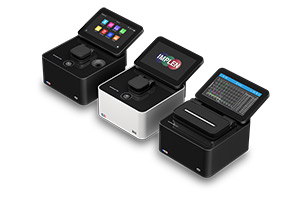NanoPhotometer®: Small Volume Spectrophotometric Applications in Biotechnology
NanoPhotometer® Application Leaflets
Small Volume Spectrophotometric Applications in
BIOTECHNOLOGY
DNA-labeling via Click Chemistry
Introduction:

Labelled nucleic acids (NAs) such as oligonucleotides, DNA or RNA, are of daily use for different standard laboratory techniques like PCR assays, FISH experiments or microarrays. State-of-the-art labelling technologies suffer from poor incorporation rates of the label and instabilities of intermediate products. The new proprietary labelling technology of baseclick GmbH, based on Click-Chemistry (Figure 1), overcomes this weakness and enables the NA labelling in an unprecedented, highly efficient and site specific way. With increased production efficiency and decrased loss of highly valuable material, the Click-Reaction significantly minimises the amount of label needed during the labelling reaction.
Quantitative and qualitative NA analysis with small sample volume is an important step before and after the Click-Reaction. Prior to the Click-Reaction it is necessary to quantify the NAs present in solution in order to define the exact amount of label-azide to be used. This step is quickly and efficiently afforded by analysing a small volume (1 µl) of the NA solution with the Implen NanoPhotometer®. A big advantage of the instrument is that the sample can be recollected after the measurement, avoiding any loss of valuable material. The quantitative and qualitative analysis due to the absorption spectrum of the labelled NAs validates subsequent experiments and ensures high quality products for the end-user. The Implen NanoPhotometer® is best suited for these two purposes. The small sample volume and easy handling are clear benefits for daily laboratory work.
METHODS
Highly efficient labelling with BaseClick™-KITs
For labelling of oligonucleotides, the baseclick alkyne-phosphoramidites were incorporate into the nucleic acids and afterwards labelled with label-azides (single- or multi-labelling) as described by Gramlich et al. 2008. Alkyne-modified oligos* can be prepared by solid phase synthesis using baseclick alkyne-phosphoramidites. BaseClick™-KITs contain all the necessary reagents to label the alkyne-modified oligonucleotides with label-azides of choice via Cu(I)-catalyzed azide-alkyne Click-Reaction (Figure 2). After a simple precipitation step, labelled oligos can be recovered in nearly quantitative yields as confirmed by the NanoPhotometer® absorption spectrum. A spincolumn purification may be necessary when using a large excess of label.
The NanoPhotometer® Pearl and the NanoDrop 2000c gave comparable results with 1.0µl and 2.0µl sample volumes with the NanoDrop 2000c having slightly higher standard deviation. Reproducibility differences are clear in smaller volumes when Nano- Drop 2000c showed significant fluctuation in values with 0.5µl while the NanoPhotometer® Pearl has reproducibility down to 0.3µl (Table 1, Fig. 4). The Nano- Photometer® Pearl is able to measure down to 25ng/µl of dsDNA with a sample volume of 0.3µl while the NanoDrop 2000c using a 0.5µl sample volume measures down to 150ng/µl illustrating therefore that the NanoPhotometer® Pearl is also significantly more sensitive with low volumes.
* Additionally, alkyne-modified oligos can be directly purchased from baseclick GmbH and other baseclick licensed companies as IDT, Metabion, Ella-Biotech and IBA.
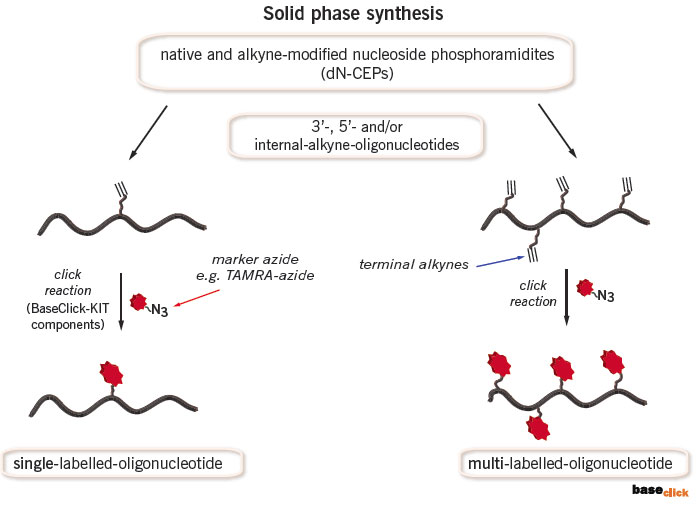
Figure 2: Solid phase synthesis of labelled DNA via Click-Chemistry.
RESULTS:
Single labelling
An oligonucleotide (22mer) bearing one internal alkyne was reacted with a slight excess of Eterneon™-(350/430)-azide for 4 h at 37°C. After ethanol precipitation and spin-column purification, 89% of the labelled oligo was recovered. The NanoPhotometer® absorption spectrum (Figure 3) shows the DNA peak (260 nm) and the Eterneon™-dye absorption peak (350 nm). The emission spectrum (Figure 3 insert) and MALDI-mass analysis (data not shown) confirm the labelled conjugate as the sole product of this reaction. The Click-Reaction performs equally under the application of various commercial dyes. For example, Figure 4 presents an absorbance spectrum achieved with the Implen NanoPhotometer® after Click-Reaction with the frequently used dye fluoresceine (FAM, 496 nm).
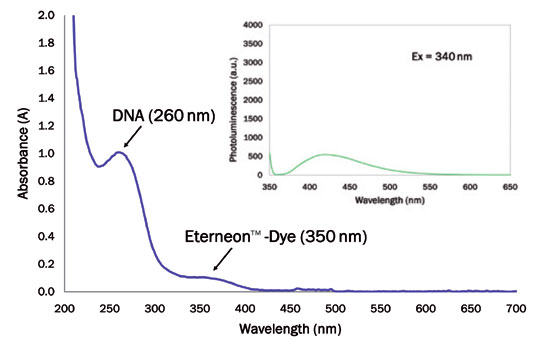
Figure 3: NanoPhotometer® absorption spectrum of a single labelled Eterneon™- 350/430-oligonucleotide conjugate after Click-Reaction. The insert shows the corresponding emission spectrum (Fluorescence-spectrometer Jasco F-750).
Multiple labeling
The Click-Reaction enables furthermore the multiple postsynthetic labelling of alkyne modified NAs. An oligonucleotide (22mer) bearing five internal alkynes was reacted with an excess of Eterneon™- (350/430)-azide for 4 h at 37°C. After ethanol precipitation and spincolumn purification, 85% of the labelled oligo was recovered. The NanoPhotometer® absorption spectrum (Figure 5) clearly shows the typical DNA peak (260 nm) along with the Eterneon™-dye absorption (350 nm) proportional to the amount of dye attached to the NAs (see Fig. 3 vs 5). Mass analysis (data not shown) and emission spectra (Fig. 5 insert) confirm the NP data. The results show a new highly modular and efficient easy-to-use method, which significantly improves the DNA-labelling and paves the way for new biotechnology applications.
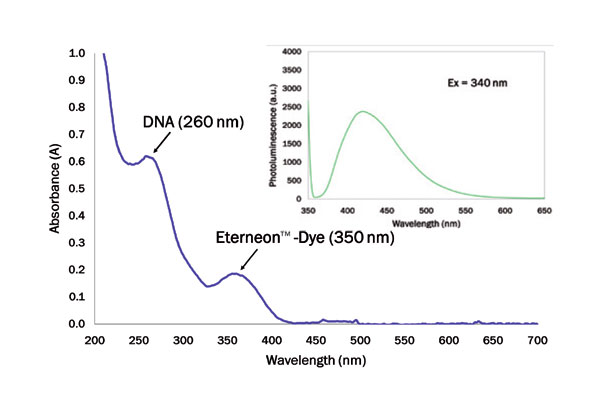
Figure 4: NanoPhotometer® absorption spectrum of a multiple labelled Eterneon™- 350/430-oligonucleotide conjugate after Click-Reaction. The insert shows the corresponding emission spectrum (Fluorescence-spectrometer Jasco F-750).
References:
P. M. E. Gramlich, C. T. Wirges, A. Manetto, T. Carell. Postsynthetic DNA Modification through the Copper-Catalyzed Azide-Alkyne Cycloaddition Reaction. Angew. Chem. Int. Ed. 2008, 47, 8350-8358. P. M. E. Gramlich, S. Warncke, J. Gierlich, T. Carell. Click-Click-Click: Single to Triple Modification of DNA. Angew. Chem. Int. Ed. 2008, 3442-3444.
SUMMARY:
Labelled nucleic acids are used in many different fi elds of research and diagnostic. They are very versatile and therefore essential for a wide spectrum of biochemical techniques. This report describes highly effi cient single- and multi-labelling of nucleic acids via Click-Chemistry. Using this baseclick GmbH patented method, nucleic acids can be easily labelled with various molecules. These include dyes, quenchers and affi nity tags, as well as peptides, lipophilic groups, nanoparticles, enzymes, antibodies, solid phases and more.
A quick determination of the nucleic acid concentration by spectro- photometric measurements plays an important role before, during and after the labelling process. The easy to handle NanoPhotometer® is the ideal tool for a fast and accurate analysis of labelled nucleic acid products. The small sample volume of less than 1 µl and the recovery of the analysed samples to avoid wasting expensive material are important advantages of the Implen NanoPhotometer® and produce the best process outcome.
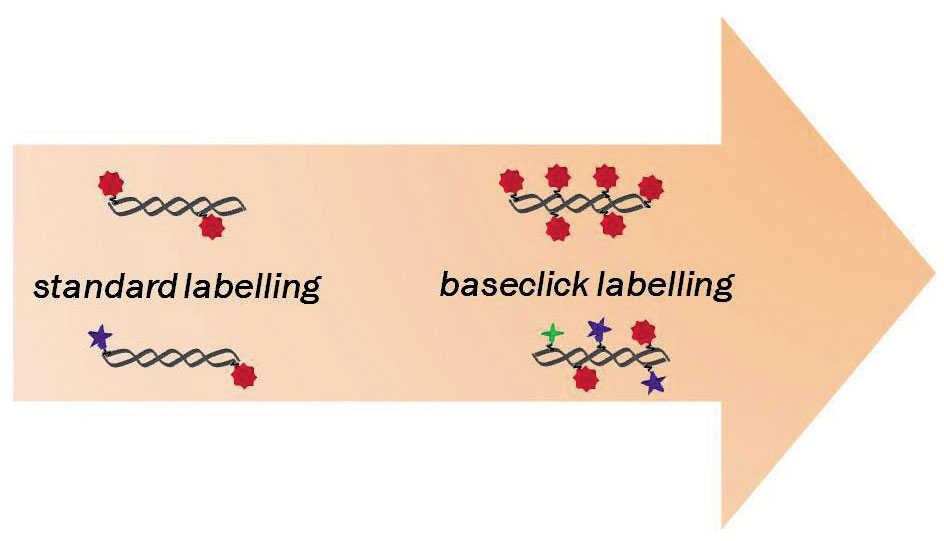
We would like to thank baseclick GmbH (www.baseclick.eu), Germany, for the friendly offer of measuring data and the title photos, and for supporting us during the compilation of this Biotechnology application leaflet!
Further applications in Biotechnology / NanoPhotometer® reference customers:
Technogenetics Srl, Sesto San Giovanni, Italy
“Quantifi cation of DNA and labelled DNA”
Faculty of Biology, University of Salamanca, Spain
“Agrobiotechnology”
Bayer HealthCare AG, Quality Control Biotechnology,
Wuppertal, Germany
“Determination of high and low concentrated proteins”

